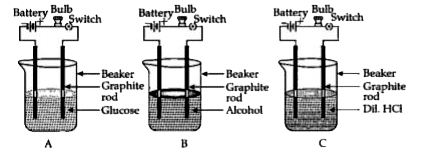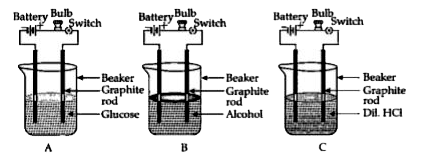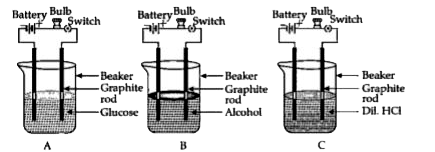Suhana takes three beakers, A, B and C filled with aqueous solutions of glucose, alcohol and hydrochloric acid repectively as shown in the following figure.

Which of the following statement is true if alcohol is replaced with NaOH solution:
bulb glows in alcohol but not in NaOH solution.
bulb will glow in NaOH solution but not in alcohol.
bulb does not glow in alcohol and neither will it glow in NaOH solution.
bulb glows in NaOH solution as well as in alcohol.
The correct Answer is:B
After replacement, bulb glows sin in B as NaOH solution contains Na+ and OH− ions, which are responsible for electrical conductivity.
Topper's Solved these Questions
- ACIDS, BASES AND SALTSBOOK - OSWAL PUBLICATIONCHAPTER - ACIDS, BASES AND SALTSEXERCISE - Self Assessment - 1 (I. Objective Type Questions) A. Multiple Choice Questions
3 Videos
- ACIDS, BASES AND SALTSBOOK - OSWAL PUBLICATIONCHAPTER - ACIDS, BASES AND SALTSEXERCISE - Self Assessment - 1 (I. Objective Type Questions) B. Passage / Table Based Questions
4 Videos
- ACIDS, BASES AND SALTSBOOK - OSWAL PUBLICATIONCHAPTER - ACIDS, BASES AND SALTSEXERCISE - ASSERTION AND REASON BASED MCQs
8 Videos
- CARBON AND ITS COMPOUNDSBOOK - OSWAL PUBLICATIONCHAPTER - CARBON AND ITS COMPOUNDSEXERCISE - CREATING BASED QUESTIONS
23 Videos
Similar Questions
Suhana takes three beakers, A, B and C filled with aqueous solutions of glucose, alcohol and hydrochloric acid repectively as shown in the following figure.

Which of the following statement is correct in terms of glowing of bulb when the switch is ON?
View SolutionSuhana takes three beakers, A, B and C filled with aqueous solutions of glucose, alcohol and hydrochloric acid repectively as shown in the following figure.

Which of the following are present in a dilute aqueous solution of hydrochloric acid?
View Solution
Knowledge Check
Which of the following statement is not true about alcohols ?
Alower alcoholes have fiery taste and strong smellBas molecular mass increases the boiling point increasesClower alcohols are water insoluble and their solubility increases with molecular weightDlower alcohols are water soluble are their solubility decrease with molecular weightObserve the following diagram and answer any four questions from (i) and (v) given below.
During an experiment, Rehana took three beakers A, B and C filled with aqueous solutions of glucose, alcohol and hydrochloric acid respectively as shown in the following figure :

Which of the following statements is correct in terms of glowing of bulb when the switch of ON ?ABulb A and B do not glow but bulb C glows.BBulb A and C do not glow but bulb B glows.CNone of the bulb glow.DAll the bulb glow.Which of the following statement (s) is/ are true for alcohols ?
ABoiling point decreases with increasing molecular mass.BAlcohols are soluble in water due to hydrogen bonding.CStraight chain alcohols have higher boiling points than the corresponding branched alcoholsDThe order of boiling point : secondary alcohol > primary alcohol > tertiary alcohol
Suhana takes three beakers, A, B and C filled with aqueous solutions of glucose, alcohol and hydrochloric acid repectively as shown in the following figure.

The bulb glows in a solution depending on whether the solution is:
View SolutionObserve the following diagram and answer any four questions from (i) and (v) given below.
During an experiment, Rehana took three beakers A, B and C filled with aqueous solutions of glucose, alcohol and hydrochloric acid respectively as shown in the following figure :

Which of the following (major ions) are present in a dilute aqueous solution of hydrochloric acid ?
View SolutionObserve the following diagram and answer any four questions from (i) and (v) given below.
During an experiment, Rehana took three beakers A, B and C filled with aqueous solutions of glucose, alcohol and hydrochloric acid respectively as shown in the following figure :

What change will be noticed if the content of beaker B is replaced by sodium hydroxide solution ?
View SolutionWhich one of the following statements is true for a solution ?
View SolutionObserve the following diagram and answer any four questions from (i) and (v) given below.
During an experiment, Rehana took three beakers A, B and C filled with aqueous solutions of glucose, alcohol and hydrochloric acid respectively as shown in the following figure :

If the property of ion formation is considered, which of the following options is correct ?
View Solution
